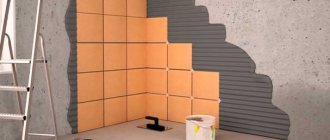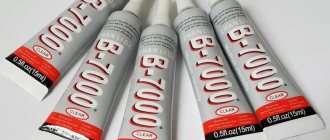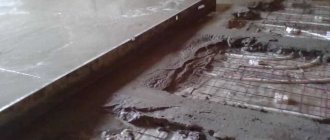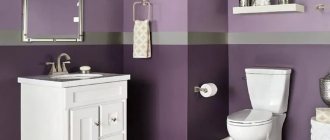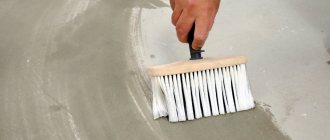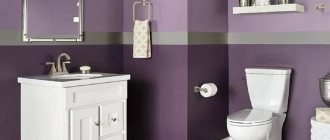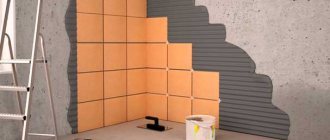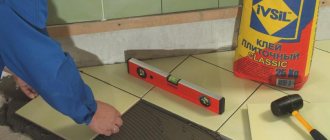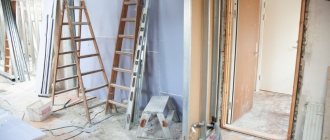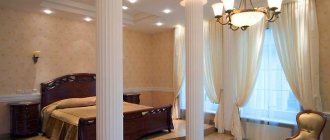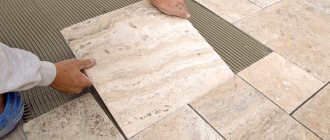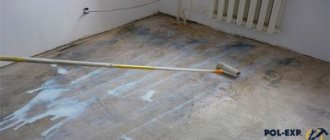Drywall is the most popular material used in construction and repair work. It can be used in any room, even in the kitchen and bathroom. Now many varieties of this material have appeared, including those with increased moisture resistance and thermal insulation. But, despite such advantages, waterproofing is necessary for drywall, especially in the bathroom. Nowadays, stores offer a wide range of different waterproofing materials.
Waterproofing gypsum board in the bathroom must be carried out
Methods for protecting plasterboard walls in a bathroom
Although moisture-resistant drywall is used in this room, additional protection would not hurt. Before installation on the frame, the sheets must be treated with mastic. It contains no organic solvents. After it dries, a waterproofing film with good adhesion appears on the surface. After erection on the frame, the edges of the sheets must be covered with silicone sealant. You can prime and apply PVA or rubber waterproofing.
We prime the corners resulting from joining the sheets and glue a waterproofing tape, its width is 20 cm. A waterproofing agent is applied on top of it. We also process external corners. The main thing is to protect the walls near the floor well. They use bitumen-based coating or pasting agents. They are applied to the floor and wall to a height of 15-20 cm. Wall partitions near the shower and bathtub are fully processed. The product is applied several times, allowing the previous layer to dry.
Pay attention to the corners on the floor, where the greatest amount of moisture accumulates
The reverse side of plasterboard sheets is treated with lining materials. First, a polymer or bitumen composition is applied, then roofing felt, glassine, or roofing material can be glued. Penetrating insulating agents are applied in a layer of 1 to 3 mm. Once they get into the structure of the material, they turn into crystals - this creates a reliable moisture-proof layer. Painting with acrylic paint is no less effective protection. It is used to process only the back side of the sheet, applying several layers. Once the front side has been painted, tiling will no longer be permitted. The paint must be waterproof, and the coating must be primed before application. Waterproofing surfaces is always highly effective if the room has good ventilation.
For greater waterproofing effect, you need to have good ventilation.
Features of additional protection of sheets from moisture during installation
We identify unprotected and cut ends of the sheet, most often these are corners, connections to the floor or ceiling. When installing, leave a gap of 3-5 cm from the floor.
The ends of the sheets in connection with the floor are additionally treated with adhesive putty; this is what will create the necessary protection.
At the junctions with the ceiling, dense polyethylene can be applied to the end, as if going around the end.
It is necessary to take into account the pipes covered with plasterboard, possible leaks at the joints and condensation formed from the temperature difference in the hot and cold water pipes. Therefore, it is advisable to insulate the pipes themselves, avoid contact with the sheet during installation, and transport the pipes correctly, cold on the bottom, hot on the top. And cover the material from the inside with waterproofing.
Painting or Tiling. The finishing of the walls in the bathroom with gypsum plasterboard is suitable for later painting, tiles, and other types of surface finishing materials.
- For further use of the surface under tiles, drywall, we prepare it without putty by priming completely or apply putty over the entire surface and then primer. You can also use reinforced mesh when filling for better aesthetic qualities.
- When finishing a bathroom with plasterboard for painting, after installing the sheets, coat the entire surface with putty or plaster, achieving a single monolithic structure, prime and paint at your discretion.
Also read: How to glue paper wallpaper
If all installation rules are followed, finishing bathroom walls with gypsum sheets is considered an acceptable method and is used by many repairmen. Note that when working with this coating, it is possible to set your own design by adding decorative elements, beautiful partitions, shelves and shaped protrusions. The choice is yours.
What type of drywall should I use?
Before starting a bathroom renovation, many people wonder: is it possible to lay tiles on drywall? There is a lot of discussion about this. No one can give an exact answer, but specialists successfully carry out such work. First you need to choose the material itself - it will be moisture-resistant drywall (GKLV), usually green. It has two layers of special cardboard and a gypsum base, to which water-repellent and antifungal components are added. Therefore, the material is protected from the appearance of fungus and mold and does not allow the absorption of liquid.
GKLV is usually green in color and has moisture-repellent properties
The best choice is gypsum fiber (GVLV) - a durable, highly reliable, strong material that has an increased service life. Suitable for rooms with a high percentage of humidity. It is important to remember that such slabs are mounted only on a metal frame; wood cannot be used under any circumstances. The distance between the profiles is reduced and is 40 cm instead of 60 cm. When you choose and buy drywall, be sure to pay attention to the thickness.
| When mounted on a wall | 12.5 mm |
| To the ceiling | 9.5 mm |
Attention! Do not forget that the cost of high-quality drywall is much higher.
When buying gypsum fiber sheets, pay attention to the thickness
Padding
When speaking about whether it is possible to paint drywall without a preliminary primer or not, experts give a negative answer. The thing is that applying a primer improves the adhesive and water-repellent properties of plasterboard. In this case, a special antiseptic should be added to the finished composition, which will prevent the appearance of mold.
As for the choice of primer, any mixture will do, except alkyd primer - it is not suitable for drywall. The primer can be applied with a roller or brush.
How to make penetrating waterproofing
Nowadays, penetrating insulation is used almost everywhere, in any room where there is a high level of humidity. When the mixture penetrates the pores and reacts with the structure of the material, crystals are formed, preventing liquid from penetrating inside. The material is suitable for any surface, reliably protects against moisture, increasing the service life of structures several times. Compared to brick and concrete, penetrating waterproofing does not penetrate very deeply into drywall. It is of great importance to treat not only the front side of the sheet, but also all its joints with the wall; it is important to apply insulation to the ends of the material.
- Before starting work, the surface is carefully prepared - cleaned of dirt and dust, primed.
- The dry mixture is diluted with water following the instructions. Then they are applied to the wall with a brush, roller, or even a spray gun. They usually write on the packaging what is best to use. You need to make several layers less than 10 mm thick, do not smear or rub in.
- Let each layer dry for about an hour and a half.
Before applying a layer of waterproofing, clean the surface
Enamel paints
Beginning repairmen often ask whether it is possible to paint drywall with enamel paint. Experts answer: not only is it possible, but it is necessary. This option is considered preferable for several reasons: firstly, enamel paints dry quite quickly, they are durable and allow you to cover the surface of drywall as tightly as possible. True, such paints and varnishes also have disadvantages. For example, they are quite toxic, which means they are not suitable for all rooms. Another disadvantage is the high cost, sometimes simply unreasonably high. It should also be taken into account that before painting with enamel, drywall must be carefully prepared: in addition to the procedures described above, it is necessary to treat the surface with PVA glue.
What are the advantages of coating materials for waterproofing?
Coating insulation is a polymer composition that forms a protective film and slightly fills drywall with its texture, which does not require moisture after treatment with mastic or paint. It is better to choose products that have a liquid texture. Most often, when covering the base, they change color, becoming green, blue or pink. This is very convenient, you can immediately see where the surface is painted and where it is not. If you are using the material as a final finish, choose a clear mixture. It is applied in several layers.
Coating waterproofing should be applied in several layers
The advantages of the material include:
- increased level of moisture resistance;
- environmentally friendly product;
- resistance to evaporation;
- strength;
- long service life;
- not subject to various types of damage;
- simplicity and ease of application, good level of adhesion;
- no seams, affordable price.
As a result, we can say that such products prevent the occurrence of fungus and mold, help maintain the microclimate of the room, and increase the service life of the constructed structure.
Such products prevent the appearance of fungi
Advantages of gypsum plasterboard staining
There are many advantages to this finishing method. Firstly, it is financial accessibility, and secondly, all painting work can be done with your own hands. Moreover, it is possible to choose exactly the color that matches the original design idea, and if you get tired of it over time, the surface can be repainted with a new one. In general, painting drywall with paint is a demanding task, but not at all difficult. How to prepare for it? Let's tell you right now.
How to properly process seams and joints
Before you begin tiling the drywall, you must properly seal the joints and seams between the sheets. You need to prepare the tools and choose the right materials. You will definitely need a primer - it will improve the adhesion of materials. First, thoroughly clean the surface from dust and dirt. We carefully cover all joints and seams with putty. Reinforcing tape is applied over the caulked seams, and the top is again treated with putty. Let it dry thoroughly, then go over the prepared seams with fine-grain sandpaper. We apply another layer of putty on them, also wait until it dries, and sand again.
Pay special attention to the corners, a lot of moisture accumulates there.
The principle of processing corners is almost the same; in addition, you will need metal corners and a corner spatula. We treat the corner with plaster, fix a metal corner on it, pressing it into the mixture. Apply putty on top of it, preferably several layers. It's okay if instead of a metal corner you use the same sickle. Cut the tape to the required length, fold it in half and apply it to the surface, then cover it with putty. Internal corners are treated in the same way. Upon completion of all work, the surface is primed, applying several layers, after allowing the previous layer to dry, this will take about an hour. The primer is applied with a roller or brush. After treatment, the surface is ready for cladding.
Corners need to be processed carefully and in several layers.
Water-based paints
When talking about what paint to paint drywall with, we cannot fail to mention water-based paints. They are incredibly easy to apply to the prepared surface, wash off easily from brushes, which means they are suitable for use even by beginners in painting. This paint has many positive properties: it creates a pleasant velvety texture, penetrates perfectly into drywall and thoroughly covers it. When painting drywall with water-based paint, a thin matte film with breathing pores is formed, completely invisible to the naked eye. It should be noted that such materials are environmentally friendly, therefore they are perfect for any residential premises.
Of course, it was not without its drawbacks. For example, the question often arises about whether it is possible to paint drywall in a bathroom with water-based paint. Let's say right away: such compositions are afraid of dampness. Therefore, water-based emulsion is not the best option for rooms with high humidity. Another disadvantage of water-based paint for drywall is that it costs too much.
Tiles on drywall in the bathroom: installation technology
First, they draw up a diagram and make markings so that the tiles look beautiful and there is as little waste and scraps as possible. For horizontal rows, we determine the zero level - we put a dot in each corner. To keep everything level, use a building level. The resulting line will be a guide for the horizontal rows; we draw vertical lines from the top.
Now you need to find out where to start cladding. To do this, measure the length of the wall and divide it by the width of the tile. If the remainder is more than half the width of the tile, work begins with a more visible area. If the remainder is less than half, then installation begins from the middle of the wall. Next, draw a line where the bottom row of whole tiles will be located. A wooden plank is fixed over it - it will support the tile until the glue completely dries.
First of all, you need to measure the length of the wall
If you use a dry mixture for gluing tiles, dilute it according to the instructions. It is important that the consistency is medium - not liquid or thick, otherwise it may affect the quality of work. The next step is to take a notched trowel, apply a layer of glue about 0.5 cm and press the tile firmly. The adhesive mixture can be applied both to the tiles and to the wall so that there are no voids. Small facing materials can be pressed down with your hands, but for large ones you will need a wooden hammer with a special attachment. Special crosses are inserted between the tiles so that the gap is the same size. Excess glue is removed as work progresses.
The glue must be applied with a notched trowel.
In this way we lay out about five horizontal rows, then be sure to pause work for about an hour so that the glue sets. Then we apply the same number of rows, and again there is a break. We repeat this until the end of the cladding. The glue dries for about a day, but it is better to wait three days before you start rubbing the seams. After the specified time has passed, remove the crosses, go over the seams with sandpaper and rub them with a special mixture using a rubber spatula. It will protect the seams from dirt and moisture. After half an hour, wash off the remaining grout.
To ensure that the distance between the tiles is the same, use special crosses
If you look at it, waterproofing drywall is not such a difficult task. If you have the slightest skills in carrying out repair work, then you can handle it yourself, you just need to do everything carefully and diligently.
Water-repellent paints
Water-repellent paints, often called water-dispersion paints, are much better suited for wet rooms. They have many advantages: they dry very quickly, do not have an unpleasant odor, and do not turn yellow over time. In addition, drywall painted with water-repellent paint can be washed up to two thousand times - the surface will not even fade. It is recommended to apply water-repellent paints in three layers. They contain a variety of components, for example, silicate, silicone, acrylic. All this affects the quality of the paint and varnish material.
Latex based paints
Having trouble choosing drywall paint that is durable and inexpensive? Professionals advise choosing latex paints.
Previously, they were made on a rubber basis, but today polymers are used for them, which has significantly reduced their price. In terms of their characteristics, such paints and varnishes are second only to silicone paints. Which latex paint for drywall should I choose? Experts recommend choosing materials such as:
- TIKKURILA EURO POWER7. This coloring is ideal for various types of surfaces, including drywall. It can be diluted with water - no more than 5-10%, the amount of water depends on the method of application. The advantages of the paint include average consumption (about 110 ml per square meter), resistance to moisture, easy care - you can use detergents to wash surfaces.
- Dufa Retail Eurolatex 3. German latex paints - an example of the highest quality combined with an affordable price. Professionals say: the paint has incredible covering power, has a long service life, and even aggressive household chemicals can be used for cleaning. The only downside is that after drying the color of the paint may become darker.
- DULUX Bindo 7 BW matte. This latex paint is characterized by a high cost. This can easily be explained by the fact that it belongs to the category of professional materials. When applied, no drips or streaks are formed, the paint does not splatter, and it is also environmentally friendly, which allows it to be used even in children's rooms and the kitchen. The covering power of the material is good; in order to paint drywall with high quality, two layers are enough. You can wash surfaces with any detergents - except those that contain abrasive components.
- NewTone Sky. Do you like snow-white walls and ceilings? Take a closer look at this paint! It is ideal for decorating plasterboard surfaces in heated rooms with normal humidity levels. You can achieve a stunning white shade with just two layers of paint. Of course, you can add different colors to the base. Among the disadvantages, experts note a rather high consumption - about 120 grams per square meter; in reviews, finishers often talk about the paint’s hiding power not being the best.
Using multiple shades
Today, painting walls in different colors is more important than ever. Working on such a coating will not take much time. First you need to draw a sketch on a sheet of paper, and then transfer it to the surface of the gypsum board using a pencil. The part that does not need to be painted immediately should be covered with masking tape. After painting, you should wait until the surface is completely dry and then continue painting the wall. Please note: you must try to carry out all the work at once, without interruption. You should not repaint a previously started surface where the paint has already dried, otherwise you will get an uneven coating and mismatched shades.
Coloring tricks
What do you need to know when painting drywall with water-based paint, latex-, silicate- and silicone-based paints? For uniform coloring, experts recommend applying paint in three layers - the first and third should be vertical, and the second should be horizontal.
Another secret from the professionals: it is recommended to start painting from the corners. It is better not to take breaks during the process, otherwise you risk getting a large number of defects. It is also not recommended to change the roller during the process.
Conclusion ↑
Only a competent approach to all repair activities allows you to obtain a decent quality result. This rule applies to absolutely all types of work.
Of course, do-it-yourself repairs are often preferred. Everyone has their own reasons: dislike of strangers, saving money, self-confidence. But whatever the reason, highly specialized work should be performed by professionals. Only then will everything be done efficiently and a decent result will be obtained.
